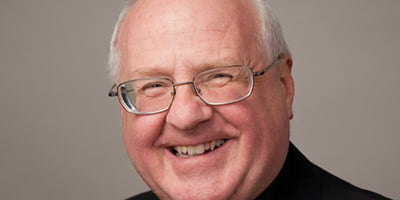
Father Mark Goldasich is the pastor of Sacred Heart parish in Tonganoxie. he has been editor of the Leaven since 1989.
by Father Mark Goldasich
“It all depends on the moon.”
This statement always gets a laugh at RCIA class each year. Inevitably, folks there will ask when they’ll be coming into the church. I explain that it happens at the Easter Vigil. Next, they ask when Easter is . . . and I tell them it all depends on the moon.
They never believe me! But it’s the truth.
The date for Easter varies from year to year — yes, depending on the moon. Honestly. Here’s how it’s figured: We look to the vernal equinox. “Vernal” means “spring,” and “equinox” means that day and night are each exactly 12 hours long. This is the first day of spring in the Northern Hemisphere.
According to the “Companion to the Calendar” by Mary Ellen Hynes (Chicago: Liturgy Training Publications, 1993; 210 pgs.; $18), Easter is “the first Sunday after the first full moon after the equinox. This can fall anytime between March 22 and April 25.” Even with this explanation, I still don’t think that some people believe me!
One of the things that I enjoy about the Catholic faith is that you never know it all. For example, to the left of this column is a list of the Mass readings for the coming week. On some days, there will be a name listed there as well. If the name is all in capital letters, it means that it’s either a solemnity or a major feast day. If the name is in regular type, it’s called a memorial, and the Mass prayers that day will refer to the saint being celebrated. If the name is in italics, that means it’s an optional memorial: The Mass celebrant can choose to celebrate that saint or not.
Each week for years now, I’ve dutifully done proofreading of that side of the page. And, each week, there’s usually a saint or two in italics that I know almost nothing about. Sadly, I’ve read over those names time and time again and done absolutely nothing to better acquaint myself with those lesser-known saints. One of the things I’ve been concentrating on in 2015 is remedying that situation.
On March 23, for instance, we celebrate a saint with a great name: Turibius de Mogrovejo. Why should we care, you might be asking yourself.
Well, for starters, he was one of the first canonized saints of the Western Hemisphere. And he’s got a great story. He was an esteemed law teacher at the University of Salamanca in his homeland of Spain. Eventually, he was named bishop of Lima, Peru. Funny thing is: He wasn’t even a priest at the time.
At age 43, he was ordained a priest, consecrated a bishop and then shipped off to Peru. Conditions there were horrific for the Peruvian people. Greedy Spanish conquistadors had enslaved the people, forcing them to work in the gold mines.
Turibius was a perfect choice for the country. According to Hynes, over the course of seven years, he traveled the 18,000 miles of his diocese to visit his people. He learned their languages so he could better teach them and understand their struggles. He spoke out against the injustices of their oppressors and brought many people into the church. One of them was St. Rose of Lima. He was responsible for the construction of churches, hospitals, schools and roads. He crossed his diocese three times as bishop. He died at age 68 in 1606, giving everything he owned to the poor before his death.
I’m ashamed to admit that I knew nothing of this wonderful saint until recently. So, what’s your “Saint IQ”?
In addition to Hynes’ excellent book, I’d recommend “Saints: A Year in Faith and Art,” by Rosa Giorgi (New York: Abrams, 2005; 780 pgs; $19.95). I bought myself a copy for Christmas because, to be honest, it was so cheap. I’ve not been disappointed.
This compact book — it’s slightly larger than a 4-by-6” file card — follows the liturgical calendar of the church. Each page features a short biography of the saint of the day, including who he or she is the protector of or patron of, and the origin of the saint’s name. For example, our friend Turibius is the protector of missionary bishops; the patron of Peru; and his name is Celtic, meaning “of the tribe of the Taurini.” On the opposite page is a 17th-century statue of this saint from the Astorga Cathedral in Spain.
If you’re looking to grow in faith, studying the saints is an easy way. You might even start with those more obscure saints — those optional memorials — in the church calendar.
Getting more familiar with our guides, the saints, will put you over the moon, inspiring you long after the celebration of Easter is over.

